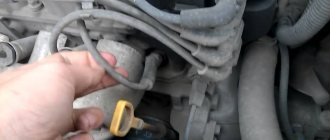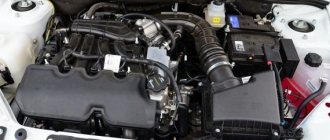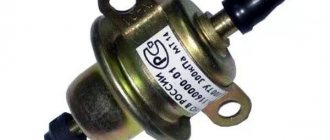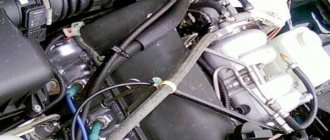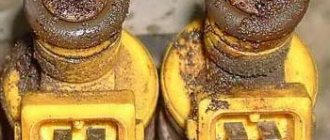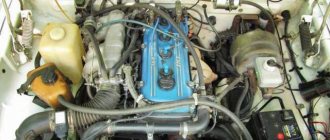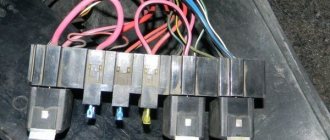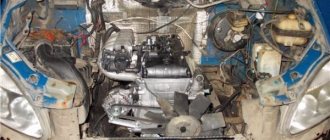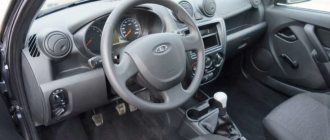The injection type of fuel system is typical for Russian-made cars and used foreign cars. Modern gasoline engines use other systems that are economical and stable in operation.
The advantage of the injector is simple and convenient maintenance. With proper and timely care, the injection system works for a long time. The only negative is high fuel consumption.
At the end of the article you can find a video demonstrating signs of an injector malfunction . It will be an excellent addition to the text material. Enjoy watching.
Signs of an injector malfunction
Using low-quality gasoline with a large number of mixtures leads to injector malfunction. The system is demanding on fuel quality.
Signs of an injector malfunction:
The engine stalls.
The engine starts and stalls for no reason. Subsequent attempts to start the engine are unsuccessful. Several minutes pass before they are successful.
Detonation.
A characteristic sign of a malfunctioning injection system. Unpleasant to the ear and destructive to the engine.
Reduced engine power.
In driver parlance, the car does not “drag.” The steep climb turns into a test of the motorist's nervous system.
Increased fuel consumption.
An uneconomical injector begins to “eat” gasoline. In advanced cases, fuel consumption increases up to 50 percent. This “hits” the driver’s pocket.
How does a fuel injection system work?
The operation of the injector, like everything ingenious, is simple and clear. Everything is tied to the vehicle’s on-board system, which regulates everything from fuel supply to exhaust gas emissions.
In short, the operation of the injector looks like this:
- Fuel is supplied from the tank to the injector by a pump;
- The injector solenoid valve regulates the level of mixing of fuel with air;
- Through the solenoid valve, the fuel-air mixture is supplied to the manifold. Valve opening time affects fuel quantity;
- The fuel-air mixture burns in the engine chamber and is released into the environment through the exhaust system.
The operation of the solenoid valve is very strictly regulated by the vehicle’s on-board computer. The supply of fuel to the engine is carried out in portions and is adjusted.
Thus, savings in gasoline consumption are achieved. It is used in the amount necessary to maintain the existing speed limit.
How to troubleshoot injector problems?
To identify the causes of an injector malfunction, you need to go through half of the car. It takes a lot of time and effort. Special diagnostic equipment is required.
Advanced cases occur among drivers who do not monitor the condition of the car. Requires time and material costs to fix the problem.
Many drivers have an indecently dirty injection system. Lack of competent maintenance and low-quality fuel take their toll.
How to troubleshoot injector problems:
Computer diagnostics.
The beginning of any renovation. Clarifies the causes of malfunctions. Special equipment is used.
Fuel injection system.
Represented by nozzles prone to contamination. It has a complex design, which makes it difficult to perform maintenance on your own without outside help.
Failure to promptly replace the fuel filter results in small dirt particles entering the injector nozzles. Normal supply of gasoline is difficult. Ultrasound is used to remove dirt and the filter is replaced.
Fuel pump.
Located in the fuel tank. Serves to supply gasoline to the injectors. Long-term operation of the pump leads to wear of its working elements.
A typical malfunction is an insufficient amount of fuel supplied to the injectors. This leads to unstable operation of the injection system. The pump cannot be repaired and must be replaced together with the fuel tank.
The injector is a reliable fuel supply system. She lost the fight to new technologies. The new generation ICE (internal combustion engine) has low fuel consumption and lower emissions of harmful substances. The injector is prone to contamination and high fuel consumption.
Thank you for your attention, good luck on your journey. Read, comment and ask questions. Subscribe to fresh and interesting articles on the site.
Clutch malfunctions, their causes and symptoms.
Clutch cannot be disengaged (pedal is pressed to the floor but shift lever does not move freely in or out of reverse)
1. Clutch contamination with oil. Remove the clutch driven disc and inspect.
2. The driven disk is deformed or damaged.
3. Fatigue loss of elasticity of the diaphragm spring. Remove the driven disk/pressure plate assembly and inspect.
4. Leak in the clutch hydraulic system. Check the master cylinder, slave cylinder and lines.
5. Air in the clutch hydraulic system. Remove air from the system.
6. Pedal travel is insufficient. Check and adjust.
7. The piston seal in the working cylinder is deformed or damaged.
8. Lack of grease on the guide bushing.
The clutch is slipping
(as the engine speed increases, the vehicle speed does not increase)
1. The driven disc is worn out or has oil on it.
2. The driven disk has not run in. It may take 30 to 40 normal engagements to break in a new clutch.
3. The diaphragm spring is weakened or damaged. Remove the driven disk/pressure plate assembly and inspect.
4. Flywheel is deformed.
5. Metal particles in the master cylinder prevent the piston from returning to its normal position.
6. Clutch hydraulic line is damaged.
Snagging (vibration) when engaging clutch
1. Oil has got onto the driven disc. Remove the disk and inspect. Eliminate the cause of the oil leak.
2. Engine or transmission mounts are worn or loose. These units may move slightly when the clutch is disengaged. Inspect the fasteners and bolts.
3. The splines on the gearbox input shaft are worn. Remove the clutch parts and inspect.
4. The pressure plate or flywheel is deformed. Remove the clutch parts and inspect.
5. Fatigue loss of elasticity of the diaphragm spring. Remove the clutch cover and pressure plate assembly and inspect.
6. Hardening or deformation of clutch linings.
7. Clutch lining rivets are loose.
Squealing or rumbling sounds are heard when the clutch is fully engaged (pedal released)
1. Incorrect pedal adjustment. Adjust the pedal free play.
2. Loosen the bearing fastening on the gearbox shaft. Remove the clutch elements and inspect the bearing. Remove any burrs or nicks; Clean and lubricate again before reinstalling.
3. The guide bushing is worn or deformed.
4. Clutch lining rivets are loose.
5. There are cracks on the clutch driven disc.
6. Fatigue of torsion springs of the driven clutch disc. Replace the driven disk.
When the clutch is completely disengaged (the pedal is pressed), squealing or rumbling sounds are heard
1. Worn, defective or broken clutch release bearing.
2. Worn or broken sectors of the pressure plate diaphragm spring
Clutch pedal remains on the floor after being released
Sticking of clutch levers and rods or clutch release bearing. Inspect the clutch levers and linkages or remove the clutch elements.
Malfunctions and repair of injection engine
Malfunctions and repair of injection engine
Although the engines are of a new generation, they still require maintenance and repair issues have not decreased. When a malfunction occurs in an injection engine in the city, there are no particular difficulties with repairs.
Undoubtedly, internal combustion engine repair https://dvigatel-msk.ru/ should be entrusted only to professionals!
But if the engine malfunctions on the road far from populated areas with service stations, then the car enthusiast himself will have to fix the injection engine, from diagnostics to repair.
The fuel pump can cause serious problems. In engines with an injector, an electric pump operates, which is installed mainly in the fuel tank. In engines with a carburetor, a fuel priming diaphragm pump is installed. If gasoline can be supplied to the carburetor manually, then if the electric fuel pump fails, the car will have to be towed.
When you turn on the ignition in a car with an injection engine, the car owner hears the whirring of the pump in the gas tank, which creates pressure in the fuel system of the car. If the sound comes from the gas tank with a different intonation, intermittently, then it is better not to go on a long journey, but to go and check the electric fuel pump.
In order for the electric fuel pump to work for a long time and without problems, you need to refuel with high-quality gasoline and periodically change the fuel filter. When water and dirt get into the pump, the electric motor of the pump quickly burns out. The electric motor of the pump heats up during operation, and gasoline cools it. But if the fuel level in the gas tank is low, the pump will fail due to overheating. When you have a trip to the mountains with a long climb, the gas tank needs to be filled completely.
An engine with an injector often has problems with idling (idling), and the engine begins to run intermittently at low speeds and does not start on the first try. In this case, it is necessary to clean the XX channels, since if the air supply regulator is not functioning properly, it is difficult to diagnose unstable engine operation. You might think that poor XX performance is not such a big problem, you just need to get on the highway and this system will not be needed, since the car will be moving at high speed.
But by the time the driver gets to the highway, especially in a big city, the engine will stall at traffic lights and in traffic jams. Frequent and long starts of an injection engine will quickly drain the battery and the driver runs the risk of not being able to reach the country road. And at traffic lights the driver will have to listen to a lot of unpleasant things about himself, since the engine will not start on the first try. And the reason for everything will be a faulty XX system and an engine overheated in traffic jams.
An engine with an injector, like any other, needs a well-functioning cooling system. Therefore, if the cooling radiator is clogged on the outside with dirt or midges, then air will not pass through it well, and the engine will overheat, which can lead to its breakdown. To clean the radiator, you need to rinse the radiator honeycombs with a jet of water under pressure and get rid of external contaminants. Leaking coolant from the radiator can also lead to overheating. If this malfunction occurs, you need to go to a specialist and eliminate the leak.
There are times when the antifreeze temperature measurement sensor in the cooling system burns out, which happens in hot weather. In this case, the car's computer does not receive data on the temperature of the coolant in the injection engine, considering the temperature optimal, and does not regulate the ignition. If the ignition is set incorrectly, the injection engine will operate with detonation and this will lead to a decrease in power. Therefore, the health of the sensor must be constantly monitored.
If, however, the engine overheats, you need to stop and turn it off. After this, you need to relieve the pressure in the cooling system by unscrewing the valve plug from the expansion tank. All manipulations must be done carefully. First, you need to throw a rag over the plug so that when you unscrew it, the released steam and hot liquid, splashing from under it, do not get on the driver. Then you need to unscrew the plug very slowly and carefully, since under the influence of excess pressure it can be torn off the thread, and a fountain of hot steam with antifreeze, if it gets on a person, can cause injury in the form of a thermal burn.
By preventing the injection engine from overheating, the car enthusiast will save himself from material losses, and the engine from expensive repairs.
Operating principle of an injection engine video:
Increased engine oil consumption
Increased engine oil consumption. Almost every car owner is concerned about increased engine oil consumption.

